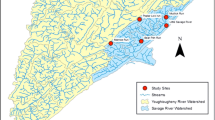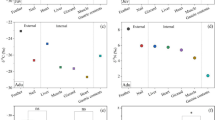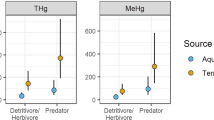Abstract
The global decline of amphibians is a major conservation issue. Many stressors are recognized for this decline including exposure to environmental contaminants. Mercury (Hg) is an environmental contaminant that bioaccumulates in wildlife and can cause a variety of negative impacts across taxa, including amphibians. Amphiuma and Siren spp. can comprise a large portion of biomass within their respective ecosystems, and thus, likely serve as important predators or prey in wetland communities. However, due to their cryptic nature, little is known about their ecology, diet, and accumulation potential. We sought to validate a nonlethal sampling method to quantify total mercury (THg) in two enigmatic species of aquatic salamanders: the two-toed amphiuma (Amphiuma means) and the lesser siren (Siren intermedia). We examined relationships between THg content in lethal (whole-body) and nonlethal (tail clip) samples. Tail clips were statistically significant predictors of whole-body THg (all p < 0.001), explaining 84–89% of variation in whole-body THg. Average whole-body THg (mg/kg) did not significantly differ between the two species (p = 0.97), and overall, they had similar whole-body THg content (S. intermedia = 0.330 ± 0.04, n = 18; A. means = 0.333 ± 0.07, n = 11). To our knowledge, these data represent the first reported Hg burdens in A. means and S. intermedia.


Similar content being viewed by others
References
Ackerman JT, Eagles-Smith CA (2009) Integrating toxicity risk in bird eggs and chicks: using chick down feathers to estimate mercury concentrations in eggs. Environ Sci Technol 43(6):2166–2172
Ackerson JR, McKee MJ, Schmitt CJ, Brumbaugh WG (2014) Implementation of a non-lethal biopsy punch monitoring program for mercury in Smallmouth Bass, Micropterus dolomieu Lacepède, from the Eleven Point River, Missouri. Bull Environ Contam Toxicol 92(2):125–131
Aresco MJ, James FC (2005) Ecological relationships of turtles in northern Florida lakes: a study of Omnivory and the structure of a lake food web. PhD dissertation. Florida State Univalent, Tallahassee, FL
Bergeron CM, Bodinof CM, Unrine JM, Hopkins WA (2010) Mercury accumulation along a contamination gradient and nondestructive indices of bioaccumulation in amphibians. Environ Toxicol Chem 29(4):980–988
Bergeron CM, Hopkins WA, Todd BD, Hepner MJ, Unrine JM (2011) Interactive effects of maternal and dietary mercury exposure have latent and lethal consequences for amphibian larvae. Environ Sci Technol 45(8):3781–3787
Burke JN, Bergeron CM, Todd BD, Hopkins WA (2010) Effects of mercury on behavior and performance of northern two-lined salamanders (Eurycea bislineata). Environ Pollut 158(12):3546–3551
Eagles-Smith CA, Silbergeld EK, Basu N, Bustamante P, Diaz-Barriga F, Hopkins WA, Kidd KA, Nyland JF (2018) Modulators of mercury risk to wildlife and humans in the context of rapid global change. Ambio 47:170–197
Gehlbach FR, Gordon R, Jordan JB (1973) Aestivation of the salamander, Siren intermedia. Am Midl Nat 89:455–463
Hampton PM (2009) Ecology of the lesser siren, Siren intermedia, in an isolated eastern Texas pond. J Herpetol 43(4):704–709
Hanlin HG (1978) Food habits of the greater siren, Siren lacertina, in an Alabama coastal plain pond. Copeia 1978:358–360
Hopkins BC, Willson JD, Hopkins WA (2013) Mercury exposure is associated with negative effects on turtle reproduction. Environ Sci Technol 47(5):2416–2422
Kennamer RA, Stout JR, Jackson BP, Colwell SV, Brisbin IL Jr, Burger J (2005) Mercury patterns in wood egg ducks from a contaminated reservoir in South Carolina, USA. Environ Toxicol Chem 24(7):1793–1800
Kilgo JC, Blake JI (eds) (2005) Ecology and management of a forested landscape. Island Press, Washington, p 479
Kvartek EJ, Carlton WH, Denham M, Eldridge L, Newman MC (1994) Assessment of mercury in the Savannah River Site environment. US DOE, Washington, D.C. WSRC-TR—94-0218ET
Mason RP, Sheu GR (2002) Role of the ocean in the global mercury cycle. Global Biogeochem Cycles 16(40):1–14
Pfleeger AZ, Eagles-Smith CA, Kowalski BM, Herring G, Willacker JJ Jr, Jackson AK, Pierce JR (2016) From tails to toes: developing nonlethal tissue indicators of mercury exposure in five amphibian species. Ecotoxicology 25:574–583
Pryor GS, German DP, Bjorndal KA (2006) Gastrointestinal fermentation in Greater Sirens (Siren lacertina). J Herpetol 40(1):112–117
R Core Team (2018) R: a language and environment for statistical computing. R Foundation for Statistical Computing. Austria, Vienna. http://R-project.org
Schalles JF, Sharitz RR, Gibbons JW, Leversee GJ, Knox JN (1989) Carolina bays of the Savannah River Plant. National Environmental Research Park Program. SRO-NERP-18
Scheuhammer AM, Meyer MW, Sandheinrich MB, Murray MW (2007) Effects of environmental methylmercury on the health of wild birds, mammals, and fish. Ambio 36:12–18
Seewagen CL (2010) Threats of environmental mercury to birds: knowledge gaps and priorities for future research. Bird Conserva Int 20:112–123
Snodgrass JW, Ackerman JW, Bryan AL Jr, Burger J (1999) Influence of hydroperiod, isolation, and heterospecifics on the distribution of aquatic salamanders (Siren and Amphiuma) among depression wetlands. Copeia 1999:107–113
Sorenson K (2004) Population characteristics of Siren lacertina and Amphiuma means in north Florida. Southeast Nat 3:249–258
Sparling DW, Linder G, Bishop CA, Krest S (2010) Ecotoxicology of amphibians and reptiles, 2nd edn. SETAC Press, Pensacola
Streets DG, Devane MK, Lu Z, Bond TC, Sunderland EM, Jacobs DJ (2011) All-time releases of mercury to the atmosphere from human activities. Environ Sci Technol 45(24):10485–10491
Tan SW, Meiller JC, Mahaffey KR (2009) The endocrine effects of mercury in humans and wildlife. Crit Rev Toxicol 39(3):228–269
Todd BD, Bergeron CM, Hopkins WA (2012) Use of toe clips as a nonlethal index of mercury accumulation and maternal transfer in amphibians. Ecotoxicology 21(3):882–887
Townsend JM, Driscoll CT (2013) Red-backed salamander (Plethodon cinereus) as a bioindicator of mercury in terrestrial forests of the northeastern United States. Ecol Indic 34:168–171
U.S. Environmental Protection Agency (1998) Method 7473 (SW-846): Mercury in solids and solutions by thermal decomposition, amalgamation, and atomic absorption spectrophotometry, Revision 0. Washington, DC
Unrine JM, Jagoe CH (2004) Dietary mercury exposure and bioaccumulation in southern leopard frog (Rana sphenocephala) larvae. Environ Toxicol 23(12):2956–2963
Wolfe MF, Schwarzbach S, Sulaiman RA (1998) Effects of mercury on wildlife: a comprehensive review. Environ Toxicol Chem 17(2):146–160
Zukal J, Pikula J, Bandouchova H (2015) Bats as bioindicators of heavy metal pollution: history and prospect. Mamm Biol 80:220–227
Acknowledgements
The authors thank Michaela Day and Christina Fulghum for their assistance with collection, preparation, and analysis of a handful of salamander tissue samples. They also thank Angela Lindell for her expertise and assistance regarding mercury analyses for this project. This research was partially supported by Savannah River Nuclear Solutions–Area Completion Projects through the U.S. Department of Energy under Award Number DE-EM0004391 to the University of Georgia Research Foundation.
Author information
Authors and Affiliations
Corresponding author
Rights and permissions
About this article
Cite this article
Haskins, D.L., Korotasz, A.M. & Bryan, A.L. Mercury Concentrations in the Two-Toed Amphiuma (Amphiuma means) and the Lesser Siren (Siren intermedia): Validating Non-lethal Sampling Methods in Southeastern Aquatic Salamanders. Arch Environ Contam Toxicol 77, 330–335 (2019). https://doi.org/10.1007/s00244-019-00657-2
Received:
Accepted:
Published:
Issue Date:
DOI: https://doi.org/10.1007/s00244-019-00657-2




